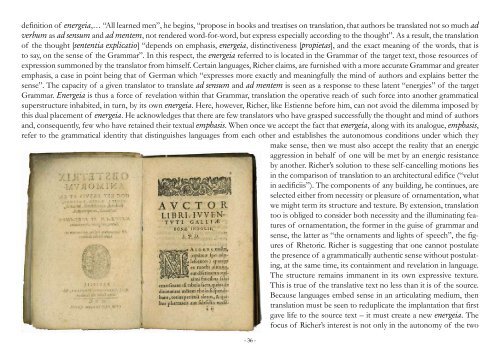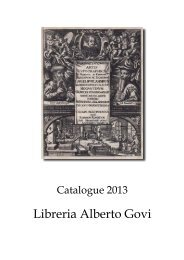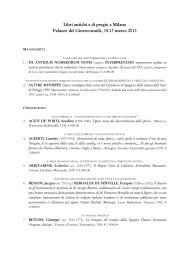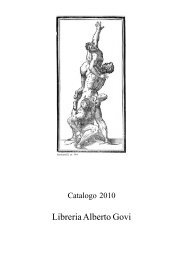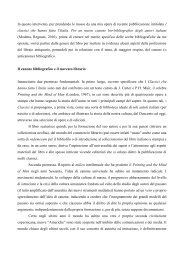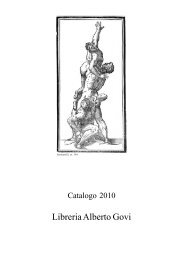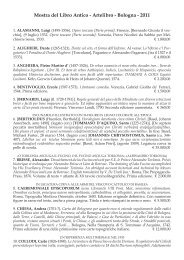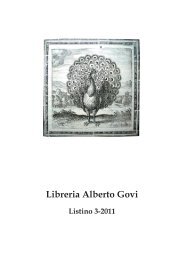List 4-2013 - Libreria Antiquaria Alberto Govi
List 4-2013 - Libreria Antiquaria Alberto Govi
List 4-2013 - Libreria Antiquaria Alberto Govi
Create successful ePaper yourself
Turn your PDF publications into a flip-book with our unique Google optimized e-Paper software.
definition of energeia,… “All learned men”, he begins, “propose in books and treatises on translation, that authors be translated not so much ad<br />
verbum as ad sensum and ad mentem, not rendered word-for-word, but express especially according to the thought”. As a result, the translation<br />
of the thought [sententia explicatio] “depends on emphasis, energeia, distinctiveness [propietas], and the exact meaning of the words, that is<br />
to say, on the sense of the Grammar”. In this respect, the energeia referred to is located in the Grammar of the target text, those resources of<br />
expression summoned by the translator from himself. Certain languages, Richer claims, are furnished with a more accurate Grammar and greater<br />
emphasis, a case in point being that of German which “expresses more exactly and meaningfully the mind of authors and explains better the<br />
sense”. The capacity of a given translator to translate ad sensum and ad mentem is seen as a response to these latent “energies” of the target<br />
Grammar. Energeia is thus a force of revelation within that Grammar, translation the operative reach of such force into another grammatical<br />
superstructure inhabited, in turn, by its own energeia. Here, however, Richer, like Estienne before him, can not avoid the dilemma imposed by<br />
this dual placement of energeia. He acknowledges that there are few translators who have grasped successfully the thought and mind of authors<br />
and, consequently, few who have retained their textual emphasis. When once we accept the fact that energeia, along with its analogue, emphasis,<br />
refer to the grammatical identity that distinguishes languages from each other and establishes the autonomous conditions under which they<br />
make sense, then we must also accept the reality that an energic<br />
aggression in behalf of one will be met by an energic resistance<br />
by another. Richer’s solution to these self-cancelling motions lies<br />
in the comparison of translation to an architectural edifice (“velut<br />
in aedificiis”). The components of any building, he continues, are<br />
selected either from necessity or pleasure of ornamentation, what<br />
we might term its structure and texture. By extension, translation<br />
too is obliged to consider both necessity and the illuminating features<br />
of ornamentation, the former in the guise of grammar and<br />
sense, the latter as “the ornaments and lights of speech”, the figures<br />
of Rhetoric. Richer is suggesting that one cannot postulate<br />
the presence of a grammatically authentic sense without postulating,<br />
at the same time, its containment and revelation in language.<br />
The structure remains immanent in its own expressive texture.<br />
This is true of the translative text no less than it is of the source.<br />
Because languages embed sense in an articulating medium, then<br />
translation must be seen to reduplicate the implantation that first<br />
gave life to the source text – it must create a new energeia. The<br />
focus of Richer’s interest is not only in the autonomy of the two<br />
- 36 -


